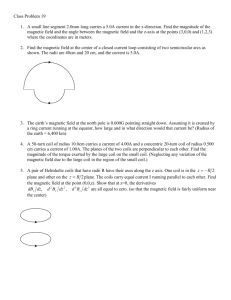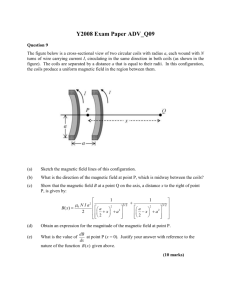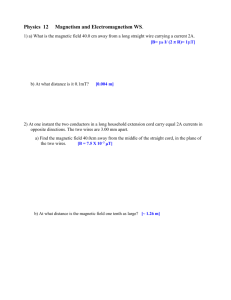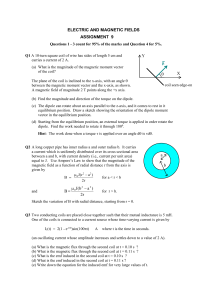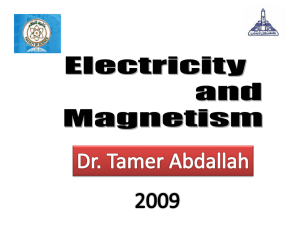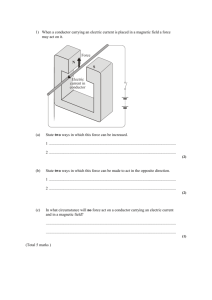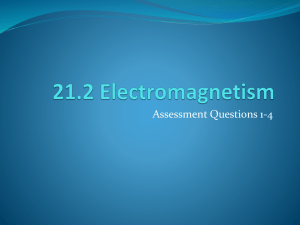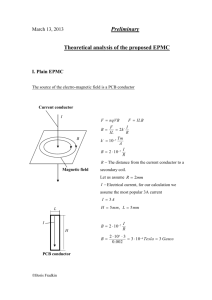Core Notes -Motors - Carlingford High School
advertisement
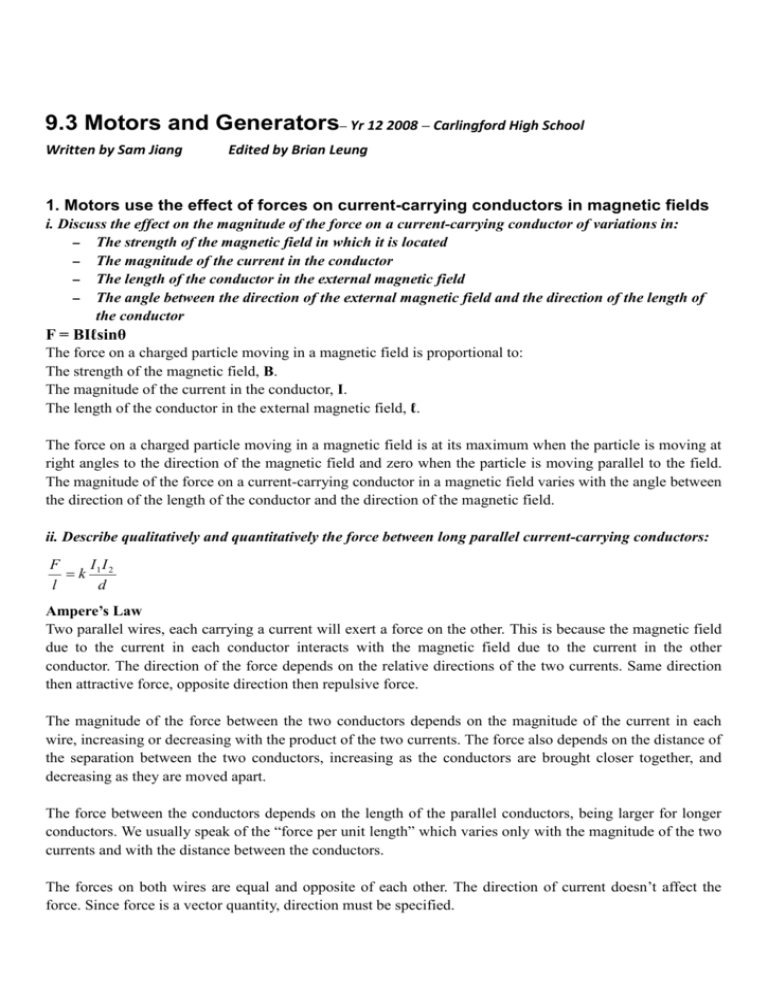
9.3 Motors and Generators– Yr 12 2008 – Carlingford High School Written by Sam Jiang Edited by Brian Leung 1. Motors use the effect of forces on current-carrying conductors in magnetic fields i. Discuss the effect on the magnitude of the force on a current-carrying conductor of variations in: – The strength of the magnetic field in which it is located – The magnitude of the current in the conductor – The length of the conductor in the external magnetic field – The angle between the direction of the external magnetic field and the direction of the length of the conductor F = BIℓsinθ The force on a charged particle moving in a magnetic field is proportional to: The strength of the magnetic field, B. The magnitude of the current in the conductor, I. The length of the conductor in the external magnetic field, ℓ. The force on a charged particle moving in a magnetic field is at its maximum when the particle is moving at right angles to the direction of the magnetic field and zero when the particle is moving parallel to the field. The magnitude of the force on a current-carrying conductor in a magnetic field varies with the angle between the direction of the length of the conductor and the direction of the magnetic field. ii. Describe qualitatively and quantitatively the force between long parallel current-carrying conductors: II F k 1 2 l d Ampere’s Law Two parallel wires, each carrying a current will exert a force on the other. This is because the magnetic field due to the current in each conductor interacts with the magnetic field due to the current in the other conductor. The direction of the force depends on the relative directions of the two currents. Same direction then attractive force, opposite direction then repulsive force. The magnitude of the force between the two conductors depends on the magnitude of the current in each wire, increasing or decreasing with the product of the two currents. The force also depends on the distance of the separation between the two conductors, increasing as the conductors are brought closer together, and decreasing as they are moved apart. The force between the conductors depends on the length of the parallel conductors, being larger for longer conductors. We usually speak of the “force per unit length” which varies only with the magnitude of the two currents and with the distance between the conductors. The forces on both wires are equal and opposite of each other. The direction of current doesn’t affect the force. Since force is a vector quantity, direction must be specified. iii. Define torque as the turning moment of a force using: = Fd Torque is defined as the turning effect or moment of a force. F is the component of the applied force perpendicular to the axis of rotation D is the perpendicular distance from the axis to the line of action of the force The unit for torque is Newton meters and the direction is clockwise or anticlockwise about an axis of rotation. iv. Identify that the motor effect is due to the force acting on a current-carrying conductor in a magnetic field Motor effect is due to the force acting on a current carrying conductor in a magnetic field. The force results from the interaction between the external magnetic field and the magnetic field produced by the movement of current in the conductor. v. Describe the forces experienced by a current-carrying loop in a magnetic field and describe the net result of the forces A current-carrying loop will produce a magnetic field, and in an external magnetic field it will experience a force and this force is determined by the right hand palm rule. Only the sides that are perpendicular to the field will experience a force and the forces in the two parts are always in opposite directions and will always be the same magnitude regardless of the angles of turning. If the coil is pivoted about the central axis, it will experience a torque due to the force acting on them, hence rotate the coil. The torque on a coil is at a maximum when the coil is located parallel to the field and reduced to zero when it is perpendicular to the field. This is because while the forces on the arms do not change the perpendicular distance between the arms is decreasing. The torque on the coil can be determined by: = nBIAcos vi. Describe the main features of a DC electric motor and the role of each feature DC electric motor is a device that transforms electric potential energy into rotational kinetic energy. Features Description Role Stator Stator is the non rotating Produce external magnetic field which interacts – Permanent magnetic part of the motor. This with the current in the armature and produce magnets usually contains a pair of motor effect. Usually arranged so that plane of the – Electromagnet permanent magnets or coil is always parallel to the field, such as curved electromagnet that is wounded surface to provide radial field. around by wires. Armature This is the frame around which The armature carries the rotor coils. The core the coil wire is wounded. The greatly concentrates the external magnetic field, armature consists of a cylinder of increasing the torque on the armature. The laminated ferro-magnetic laminations reduce eddy currents which might materials (usually iron) mounted otherwise overheat the armature and consume the on an axle. energy. Rotor coil(s) There may be only one, in a very The coils prvides pathway for the currents, hence simple motor, or several coils, providing the torque as the current passing usually of several turns of through the coils interacts with the external insulated wire wound onto the magnetic field. As the coils are mounted firmly on armature. The ends of the coils the rotor the torque acting on the coils will are connected to bars on the transfer to the rotor and hence to the axle. commutator. Commutator It is a broad ring of metal The commutator provides points of contact mounted on the axle at one end of between the rotor coils and the external electric the armature and cut into an even circuit. It also reverses the direction of the current number of separate bars (two in a flow in each coil every half revolution of the simple motor). Each opposite pair motor (or when the torque falls to zero), ensuring of bars is connected to one coil that the direction of the torque on each coil is always constant. Brushes Compressed carbon blocks, The brushes are conductors that make electrical connected to the external circuit, contact with the moving split metal ring of the mounted on opposite sides of the commutator, hence allow the electrical contact commutator and spring loaded to between the external circuit and the rotor coils. It make close contact with the also works as a lubricant. Their fixed position commutator bars. brings them into contact with both ends of each coil simultaneously. vii. Identify that the required magnetic fields in DC motors can be produced either by current-carrying coils or permanent magnets The magnetic field can be produced using permanent magnets (two bar magnets or a horseshoe magnet), called field magnets, or by an electromagnet, called a field coil. When using permanent magnets, opposite poles are placed on opposite sides of the armature. Electromagnets can also be used and are made by winding a conductor around an iron core. Radical magnetic fields are often used to maintain constant torque. e. Identify data sources, gather and process information to qualitatively describe the application of the motor effect in: – The galvanometer – The loudspeaker Galvanometer A galvanometer is a device used to measure the magnitude and direction of small DC currents. The motor effect is employed in a galvanometer. The current flows through the coil with a soft iron core, producing a magnetic field around it. This magnetic field then interacts with the permanent magnets’ field, producing a force on either side of the coil. The force then produces a torque in proportion to the magnitude of the current. This turns the coil and the needle attached to it. As the coil turns the restraining spring tightens and coil stops when the restoring force in the spring equals the torque. The permanent magnets have curved pole faces around the coil to ensure that the torque at all the angles will be a constant and maximum. Thus, the scale (deflection of the needle) is linear and calibrated and we are able to read off the measurements of current/voltage accurately. Loudspeaker In a loudspeaker, the amplified microphone current or an AC current passes through a coil attached to a speaker cone, producing electromagnetic field. The magnetic field interacts with the surrounding fixed permanent magnets’ field, producing a force of either attraction or repulsion. The electromagnetic field continually reverses its polarity in rhythm to the voice current AC. The voice coil then repels or attracts, producing vibration identical to the audio signal fed into it. This vibration is then carried out to the cone, producing compression sound waves and thus we can hear it. The intensity of the sound is proportional to the current in the voice coil. The pitch of the sound is determined by the frequency of the AC current input. The higher the frequency the higher the pitch. 2. The relative motion between a conductor and magnetic field is used to generate an electrical voltage i. Outline Michael Faraday’s discovery of the generation of an electric current by a moving magnet Faraday’s idea about conservation of energy led him to believe that since an electric current could cause a magnetic field, a moving magnetic field should be able to produce an electric current. This principle of electric generator was demonstrated in 1831 through two experiments. For the first experiment, he moved a magnet into and out of a coil and noticed that the ammeter in the circuit give a reading of current whose direction depend on the direction of movement of magnet. For the next experiment, Faraday wrapped two coils around opposite sides of a soft iron ring. The first coil was connected to a switch and power supply, and second coil connected to a galvanometer. He noticed that when he switched the current on and off continuously in the first circuit, a current was induced in the second circuit. When the current flowed continuously in the first coil, No current was induced in the second coil. He concludes that the changing magnetic field produced by the current in the first circuit induced current in the second circuit. He then concludes this electromagnetic induction as: When there is a relative movement between conductor and magnetic field (physical movement of coil/magnet, or change in magnitude of magnetic field strength), a potential difference is generated in the conductor. If the conductor is part of an electric circuit, a current is induced in the circuit. The magnitude of the induced current is directly proportional to the rate at which the conductor “cuts through” the magnetic field, number of coils and the strength of the magnet. ii. Define magnetic field strength B as magnetic flux density Magnetic flux is a measure of the amount of magnetic field lines permeating a given space. It is measured in Weber (wb). Magnetic flux density is a measure of the number of field lines (or magnetic flux) per unit area. In other words is a measure of the magnetic field strength. The unit is B (tesla) or Wb/m2 iii. Describe the concept of magnetic flux in terms of magnetic flux density and surface area = BA Where B is a measure of magnetic flux unit area perpendicular to the direction of the field at a point in a field, in other word, magnetic flux density. A is surface area of the conductor. This means that the more surface area there is in the conductor, the stronger the magnetic flux density. Also, the stronger the magnetic field is at a point, the higher the magnetic flux density and the more magnetic flux there are. B and A are directly proportional to flux. iv. Describe generated potential difference as the rate of change of magnetic flux through a circuit As Faraday states, whenever there is relative motion between a conductor in a circuit and a magnetic field, an emf is generated in the conductor, if the conductor is part of a circuit, then a current will be induced. When there is a relative motion, there is a change of the magnetic flux penetrating through the conductor. It is this change that generates the potential difference and the magnitude of the emf depends on the rate of change of the flux. v. Account for Lenz’s Law in terms of conservation of energy and relate it to the production of back emf in motors Proposed by Heinrich Lenz, Lenz’s Law states that an induced current will always flow in a direction on which will oppose the change that created it. Lenz’s law is a consequence of the law of conservation of energy. It states that energy cannot be created nor destroyed but can simply change form. Consider the example where a current is produced by inserting a magnet into a coil connected into a circuit with a galvanometer to show current flow direction. In order to produce electrical energy in the coil (current flow), energy must be transferred to the coil, therefore work must be done to provide that energy. If the south pole of a bar magnet is inserted into the coil the current induced in the coil will flow in a direction such that it produces a south pole opposing the insertion of the bar magnet. Pushing the bar magnet against that field means that work must be done. If the same magnet is pulled out of the coil from the same end the current induced in the coil will be in the opposite direction so that it produces a north pole that attracts the south pole of the magnet being withdrawn. This attraction means work must be done to pull the magnet out of the coil. It is necessary that work must be done against the magnet moving relative to the coil if it is to generate the emf in the coil. If it were no so, the induced magnetic field would accelerate the magnet, thus increasing the induced emf which, in turn would increase the strength of the induced field, further accelerating the magnet, and so on, producing infinite energy without work being done, contravening the Law of Conservation of Energy. In a motor an external emf is applied to the coils to produce an electric current such that the magnetic field produced will interact with the external magnetic field. The coil will then experience a force and rotates, as the coil rotates, there is a change in the magnetic flux treading through the coil, therefore generated another emf in the coil. According to Lenz’s law, the induced emf will flow in an direction that oppose the change that create it, it is the external emf supplied to the coil that produced this, so the direction of the induced emf will be in the opposite direction to the supplied emf, reducing the net emf applied to the coils, this is known as the back emf. vi. Explain that, in electric motors, back emf opposes the supply emf See above The back emf increases as the speed of the motor increase, until the net emf is just sufficient to provide the energy for the work that the motor is doing, against its own internal friction and any load that is applied to it. If there were no back emf, the motor would continue to spin faster and faster indefinitely. When a greater load is applied to the motor, the armature rotates more slowly and the back emf is reduced. This allows a greater current to flow through the coils, resulting in an increased torque to match the extra load. At low speeds, when the back emf is small, the motor coils are protected by a series resistor from the large currents that could flow and burn out the motor. This resistor is switched out at higher speeds when the back emf replaces the role played by the resistor at low speed. The net voltage across the coil= input voltage-the back emf V=IR vii. Explain the production of eddy currents in terms of Lenz’s Law When a conductor is subjected to a changing magnetic flux (relative motion between the magnetic field and the conductor), an eddy current is produced. Eddy current is a circular or whirling current induced in a conductor that is stationary in a changing magnetic field, or that is moving through a magnetic field. Eddy currents are application of Lenz’s law and will set up in a way that opposes the changes that create it. c. Gather, analyse and present information to explain how induction is used in cooktops in electric ranges Each cooking area on the ceramic induction cooktop has one or more coils wound on ferromagnetic material under it. A high frequency alternating current is passes through these coils producing a fluctuating magnetic field. When a ferromagnetic based pan is placed over the coils, eddy currents are induced in the base because of the fluctuating magnetic field being cut by the coils. They are separated by the ceramic top plate. The pan must be made from a ferromagnetic metal that is a conductor and has a high internal resistance to the eddy current induced. The resistance to the eddy currents within the pan transformed the electrical energy into heat energy, and is dissipated to the food in the pan. d. Gather secondary information to identify how eddy currents have been utilised in electromagnetic braking Electromagnetic braking is used in many vehicles. Two coils are placed at each side of a copper plate, which is attached to the wheel. When applying the brakes, current will pass through the two coils, setting up magnetic fields. The rotating copper plate due to the wheels will cut the generated magnetic field flux, generating eddy currents due to the change in magnetic flux. The eddy currents will set up in a way that opposes the original magnetic field that creates it, thus opposing the wheel’s motion (Lenz’s Law). This results in the motion of wheel slowing down and thus brakes. Since the magnitude of the eddy current is proportional to the speed of the wheel through the magnetic field, as the wheels slows, eddy current reduces, so deceleration is smooth, yet this also means that the motion would not stop completely at slopes since when wheel stops, there is no eddy current to hold the wheel in stopping position, and the slopes will result in the wheels to move again. Maintenance costs are less as there is no physical contact (friction) between the wheels and the brakes. Electromagnetic brakes are used in free-fall rides in theme parks, roller coasters and fast trains. 3. Generators are used to provide large scale power production i. Describe the main components of a generator Components Rotor Armature Coil Stator Description In its simplest form, the rotor consists of a single loop of wire made to rotate within a magnetic field. In practice, the rotor usually consists of several coils of wire wound on an armature. The armature is a cylinder of laminated iron mounted on an axle. The axle is carried in bearings mounted in the external structure of the generator. Torque is applied to the axle to make the rotor spin. Each coil usually consists of many turns of copper wire wound on the armature. The two ends of each coil are connected either to two slip rings (AC) or two opposite bars of a split-ring commutator (DC) The stator is the fixed part of the generator. It supplies the magnetic field in which the Field electromagnets Brushes coils rotate. It may consist of two permanent magnets with opposite poles facing and shaped to fit around the rotor. Alternatively, the magnetic field may be provided by two electromagnets Each electromagnet consists of a coil of many turns of copper wire wound on a soft iron core. The electromagnets are wound, mounted and shaped in such a way that opposite poles face each other and wrap around the rotor. The brushes are carbon blocks that maintain contact with the ends of the coils via the slip rings(AC) or the split ring commutator (DC), and conduct electric current from the coils to the external circuit. The split ring acts as a switching device to change the direction of the current delivered every half rotation if DC output is required. ii. Compare the structure and function of a generator to an electric motor The structure of a motor and a generator are almost identical. It is their purpose and operation that differ. They both consist of a stator that provides a magnetic field and a rotor that rotates within the magnetic field. In both motors and generators the magnetic field may be supplied either by permanent magnets or by electromagnets. The rotor in both an electric motor and a generator consists of coils of wire wound on a laminated iron armature and connected through brushes to an external circuit. This is connected via a slip rings commutator in AC or a split ring commutator in DC. Motors convert electrical energy into mechanical energy, thus they have an electrical input structure and output mechanical energy via their rotating armature. Generators convert mechanical energy into electrical energy and thus have an energy input structure which allows mechanical energy to rotate the armature and output electrical energy that is replayed into an external circuit. iii. Describe the differences between AC and DC generators DC Generator has a split-ring commutator which changes direction of output current every half rotation so it is in a constant direction – called fluctuating DC AC Generator uses slip rings commutator which naturally produce AC b. Gather secondary information to discuss advantages/disadvantages of AC and DC generators and relate these to their uses DC AC – DC generators and transmission lines – AC generators have fewer moving parts Advantages do not emit EM radiation so won’t and require less maintenance. It has interfere with other electronic continuous, smooth surface so the equipment or signals brushes do not wear as fast as in a DC – The output of a DC generator can be generator. Most commercial generators made smoother by including more are AC. coils set at regular angles on the – AC current is easy to transform, power armature. The more coils, the can be transmitted at high voltage and smoother the output DC voltage, this low current, minimising energy loss, is use for equipment that needs a therefore are used to transmit large steady voltage rather than a amount of energy over long distance. sinusoidally varying voltage. – AC generators can easily be designed to produce three phase electricity by the use of six stator poles and a single electromagnet rotor. The coils are mounted in opposing pairs spaced evenly around the stator, and connected in pairs to the three phases of the power supply. It is very powerful for industry use. – AC transmission is associated with EM Disadvantages – DC cannot be transformed so difficult to distribute over large distance radiation and health problems – DC generators can be less reliable due to sparking and wear out across commutators. They need to be replaced regularly. The sparking causes interference with other equipment iv. Discuss the energy losses that occur as energy is fed through transmission lines from the generator to the consumer Heat is generated in transmission lines because of the resistance of the wires. The resistance per kilometre is small, but the resistance of a long transmission line is significant. Power stations are often located in remote places, rarely close to consumers in the city The power loss in transmission lines is give by the formulae P=VI or P=I2R. Power loss is proportional to the square of the current. As the resistance of the conductor is relatively constant, power loss is affected most by the size of the current. Energy losses are kept to a minimum by transmitting the electricity at the highest practicable voltage, with the lowest practicable current. Therefore the type of electricity transmitted over long distances is predominantly AC, since AC can change voltages easily by transformers. Energy losses can be minimised through careful choice of materials and design of conductors. Transmission lines are typically made of good conductors such as copper or aluminium which have low resistance. Energy is also lost through the induction of eddy currents in the iron core of transformers and generators. The circulation of eddy currents transforms the electrical energy into heat energy. Laminated core limits eddy currents to the thickness of one lamina and reduces the lost. v. Assess the effects of the development of AC generators on society and the environment The development of AC generators has led to the widespread application of some of the useful features of AC electricity. AC generators are simpler and cheaper to build and operate than DC generators. Because AC electricity can easily be transformed, it can be transmitted cheaply over great distances, allowing a wide range of primary energy sources to be exploited. This has allowed the development of extensive, reliable AC electivity networks for domestic and industrial use throughout much of the world. Positive effect on society Negative effect on society The affordability of electricity has promoted the Reduction in the demand for unskilled labour and an development of a wide range of machines, processes increase in long term unemployment, affecting on and appliances that depends on electricity. Many government welfare programs, family lifestyle and tasks that were once performed by hand are now stability. Crime rates may have increased as some accomplished with electrical appliance. Industrial people struggle to survive. work requires less labour and the production is more efficient. This in turns produce a greater demand for Increasing dependency on electricity. Essential the product and more employment to increase services such as hospitals are forced to have back up output. electricity supply. A major electricity failure will causes widespread The ability to transmit electricity over long distance inconvenience and loss of production, even an revolutionised communications, refrigeration and economic crisis. food storage in isolated areas. Personal comfort improved with air conditioning and electric Ugly power lines cross the country side, ugly power blankets, toy variety, leisure activities, movies, TV, poles and lines in streets also offer impact sites for CDs, kitchen appliances, workshop tools, lawn accidents, so increasing the death tool from transport mowers. accidents. Transformers in substations and pole mounted in streets are not visually attractive. The use of calculators and computers has changed Possible harmful effects from high frequency the nature of many aspects of education and work electromagnetic radiations are associated with high and enabled easy access to data and information via AC voltage transmission. Internet. High voltage appliances such as TV increased communications and leisure opportunities, allowing people to be in touch with world events. Positive effect on environment Electricity reduced pollution from trains by using electrical engine rather than steam engine. Producing less heat, less fuel waste pollutants, cleaner air. Power stations could be placed away from cities, since long distance transmission is possible, reducing pollution. Negative effect on environment Atmospheric pollution has increased enormously as more and more demand for electrical power has been met over the years. Heat pollutions from coolant water into natural streams have affected water quality and life. In turn affects people’s leisure activities such as fishing There is an increased waste from disposable electronics as heavy metals are toxic to the Better environment for people to live, therefore a environment. better general health. Incidents of asthma and Ordinary power stations produce heat and carbon allergic conditions caused by particulate pollution in dioxide, contributes to green house emission. the air decreased. The quality of life for people Nuclear power risks accidents such as nuclear waste improved as better health meant greater ability to disposal, radiation hazards and social unrest. work, so more reliable income to provide essentials Hydroelectricity schemes affect natural habitat, the for living. cutting down of trees and forest, destroying home electrical light replaced conventional fuel methods. for animals. Although AC generators raised our living standards, we have not yet learnt to live with it in a sustainable way. These negative social and environmental effects seem likely to be long lasting, as right now a compromise between this and economic interests & entertainment will likely to favour the latter. c. Analyse secondary information on the competition between Westinghouse and Edison to supply electricity to cities In the late nineteenth century, the competition between Edison and Westinghouse centred around the provision of electric energy to cities in the USA. Edison had development a system of DC distribution and he did not want to lose this aspect of his livelihood therefore he favoured direct current electricity while Westinghouse promoted the use of alternating current. Edison had the initial advantage that the technology for generating DC as well established and DC worked well over short distances. However, DC could only be generated and distributed at the voltages at which it was used by consumers. This meant that currents in conductors were large, leading to huge and expensive energy losses over distances. Westinghouse advocated the advantages of AC energy. Through the use of transformers invented by Nikola Tesla the voltage could be stepped up or down as required. This meant that AC could be generated at moderately low voltages, stepped up to high voltages for transmission and stepped down again to lower voltages for consumers. It can be transmitted over greater distances than DC with smaller energy losses. Competition was not always open and fair. Edison had a vested interest in DC since he owned hundreds of DC power stations and all of his many electrical inventions to that time ran on DC. Edison’s tactics were often less than honest, he lobbied politicians to pass laws prohibiting the use of AC above 250V, while recommending 800V for his DC. He attempt to prove that AC was very dangerous by electrocuting animals on stage and convincing authorities to use AC for the first electric chair. He lost credibility because of his vocal support. As time pass more people start to prefer AC rather than DC. Westinghouse started to win the battle, for example by 1896, 10 AC generators supplied New York City with lights, running street railways and subway systems. Edison was finally convinced of his defeat and the superiority of AC distribution. d. Gather and analyse information to identify how transmission lines are: – insulated from supporting structures – protected from lightning strikes High voltage transmission lines are kept away from their supporting structures by chain insulators to reduce the likehood of a discharge between the conductor and the support structure. Insulators are constructed either of ceramic segments joined together with metal links or of rubber discs with a fibre glass core. Their design reduces the possibility of charge leaking through the insulators themselves. The metal links in ceramic insulators are isolated from each other, and the fibre glass is not a conductor, so there is no continuity of conduction. The insulator segments are designed to shed water and prevent dust from building up, as either moisture or dust can make a conductive path across the surface of the insulator. The disc like shape of the segments whether ceramic or rubber ensures a long pathway for any spark discharge across the insulator. Transmission towers may be hit by lightning strikes, thus several design features help to prevent it: Shield conductors: these are two non-current-carrying wires at the very top of the tower. Because they are at the highest position, they are more likely to be hit by lightning than the towers, thus acting as a shield. Earth cable: runs from top of pole to bottom of earth so lightning energy goes directly to earth. Insulation chains: saucer shaped stacks of ceramic material used as joints between transmission wires and other structure such as supporting tower, isolating the wires. Metal tower: set deeply into the ground, energy from lightning will flow through tower to the ground. Distance: distance between towers is at least 150m, so if one tower is damaged others won’t be affected. 4. Transformers allow generated voltage to be either increased or decreased before it is used i. Describe the purpose of transformers in electrical circuits A Transformer is magnetic circuit with two multi-turn coils (the primary and the secondary) wound or connected onto a soft iron core. It uses the principle of mutual induction, when an AC current flow through the primary coil, a constantly changing magnetic flux is threading through the secondary coil, producing an AC voltage at the terminals with the same frequency, but different magnitude. Therefore transformers are devices that change electricity at one electric potential (Voltage) to electricity at another electric potential. Domestic supply voltage at Australia is 240V single phase AC, while some appliance (light) can operate directly at these voltages, many appliances voltages require well below (phone charger, electric blanket, semi-conductor devices) or well above (television), hence transformers are required in the circuit (most time transformers are built in) Transformers are also used to step up the voltage of electricity from power station to reduce the power loss when transmitting electricity over long distance. ii. Compare step-up and step-down Transformers Step-up Transformer Step-down Transformer Consists of two inductively coupled coils wound on a laminated iron core More turns in the secondary coil than the Fewer turns in the secondary coil than the primary coil primary coil Higher output voltage than input voltage Lower output voltage than input voltage Lower output current than input current Higher output current than input current Used at power stations to increase voltage and Used at substations and in towns to reduce reduce current for long-distance transmission transmission line voltage for domestic and industrial use Used in television sets to increase voltage to Used in computers, radios, and CD players to operate the picture tube reduce household electricity to very low voltages for electronic components iii. Identify the relationship between the ratio of the number of turns in the primary and secondary coils and the ratio of primary to secondary voltage The ratio of primary to secondary voltage in a transformer is the same as the ration of the number of turns in the primary and secondary coils. Mathematically: VP n P VS n S VP is the voltage in the primary coil VS is the voltage in the secondary coil nP is the number of turns in the primary coil nS is the number of turns in the secondary coil iv. Explain why voltage transformations are related to conservation of energy The law of conservation of energy states that energy cannot be created nor destroyed, but it can be transformed from one into another. The amount of electrical energy entering a transformer in a certain time must equal the total amount of energy in all forms leaving the transformer in the same period of time, That is, power in equals power out. However no electrical device is 100% efficient, therefore primary power is greater than secondary. The rate of supply of energy is known as power and is found using P=VI In 100% efficient transformer PP = PS VpIp = VsIs VP I S VS I P Combining with the transformer equation, we get I S VP n P I P VS n S v. Explain the role of transformers in electricity sub-stations Electricity from power stations is transmitted through the national grid at very high voltages (up to 500kV in Australia). The high voltages are necessary to minimise energy loss due to resistance in the conducting transmission. However this is much higher than those required to operate most industrial and domestic equipment and appliances. The role of transformers in electricity sub-stations is to progressively reduce the voltage as it comes closer to the consumer. At each stage, the output voltage is chosen to match the power demand and the distances over which supply is needed. vi. Discuss why some electrical appliances in the home that are connected to the mains domestic power supply use a transformer Electricity supplied to homes is typically 240V AC. Many domestic appliances are designed to run most efficiently at this voltage. Such appliances are connected directly to the main supply without the need for a transformer. Some appliances contain components that require a transformer because they operate best at lower voltages than the mains supply. In a microwave oven, large, energy consuming parts such as the turntable motor and the microwave transducer may be connected directly to the mains, while the control and display panel is supplied with low voltages from a step-down transformer in a built-in power supply unit. Many small portable appliances, such as personal CD players and mobile telephones, have been designed to run on batteries. These require low DC voltages, either as an alternative to batteries or to recharge the batteries. When the whole appliance is designed to run at the same low voltage, a step down transformer rectifier may be built into the plug of the power supply lead that connects to the main supply. Alternatively, a normal power lead connects the mains to a built in power supply unit that contains a step down transformer and a rectifier. Some appliances such as electric blanket contain a step down transformer to step down the voltage due to safety reasons. Appliances such as television receivers and computer monitors contain cathode ray tubes that require voltages well above the main supply, up to around 25kV, to accelerate electrons toward the screen. These use a built in step up transformer to provide the necessary voltage. vii. Discuss the impact of the development of transformers on society The development of transformers made it possible to transmit electrical energy efficiently over great distances. This has had a range of impacts on society. Even very remote communities now have access to grid-supplied high voltage electricity which is stepped down locally by transformers. This has raised living standards in rural communities through provision of, for instance, electric lighting, refrigeration and air conditioning, and increased the scope of rural industries. Large cities have been allowed to spread, because electricity is readily available as an energy source. This has led to social dislocation in urban deserts, as people have moved further from family, friends and workplaces. Industry is no longer clustered around power stations or other sources of energy. Power stations can be in remote locations and high voltage electrical energy can be distributed almost anywhere, to be steeped down near the point of use. This has allowed industries to be decentralised and has facilitated the development of industrial areas away from residential areas. This has relocated pollution away from homes, but also means that many people spend significant time travelling between home and work. Lifestyle for people have changed through the use of power tools at home, saving money on hiring others to do the work and the labour saving devices such as frypans, mixers, vacuum cleaners all would not be available without the transformers making the supply AC voltage into suitable voltage. The transformers making the supply AC voltage into suitable voltage also enabled greater leisure and entertainment devices such as TV and computer, which require higher voltage than the AC voltage supplied. c. Gather, analyse and use available evidences to discuss how difficulties of heating caused by eddy currents in transformers may be overcome A transformer has an iron core to concentrate the magnetic field to achieve the maximum possible inductive coupling between the primary and secondary coils. As the changing flux intersects the core, eddy currents are induced in the iron and heat up the iron. This heat represents a power loss to the electrical system and excessive heating can damage or destroy the transformer. One of the best ways to overcome difficulties of heating in transformers is to reduce the size of the eddy currents by laminating the iron cores. Many thin sheets of iron pressed together but separated by thin insulating layers. This limits the circulation of any eddy currents to the thickness of one lamina, rather than the whole core, thus reducing the overall heating effect. Once the transformer does get hot it must be cooled to prevent overheating. Several strategies have been developed to keep transformers cool: Heat-sink fins are added to the metal transformer case so that heat dissipation to the environment can occur more quickly over larger surface area The transformer case may be made of a back material so that the heat produced internally is efficiently radiated to the environment. Pad-mounted transformers at ground level have ventilated cases to allow air to remove hat by convection. They may also have an internal fan to assist air circulation to remove excess heat faster. The transformer case may be filled with non-conducting oil that transports the head produced in the core to the outside where the heat can be dissipated to the environment. Large transformers such as at substations are always located in the open or in well ventilated areas to maximise airflow around them for cooling. These are fitted with a combination of cooling mechanisms including pumps to circulate coiling oil through large radiator, and fans to increase the airflow over the radiators. The fans are often thermostatically controlled and cut in at a specified temperature, usually around 50. d. Gather and Analyse secondary information to discuss the need for transformers in the transfer of electrical energy from a power station to its point of use Electricity is typically consumed in homes and industry at 240V or 415V. If there were no transformers, electricity would have to be generated and distributed at these voltages. To supply the power demands of even a small town, the current at these voltages would be very large, leading to large and costly transmission losses and possible overheating of conductors. If the power demand were to increase, the number of conductors would need to multiply, to keep the current per conductor within reasonable limits. For a large city there would need to be many power stations spaced every few kilometres. If different voltages were needed, these would require separate power stations and separate distribution systems, adding to the network of cabling required. The result would be an expensive, unsightly, unreliable web of cables serving consumers only within a limited distance from each power station. Transformers with AC electricity overcomes many of these problems. It is more efficient to generate electricity at high voltages, such as 23 kV than at low voltages. Power stations can run efficiently at their design voltage and different transformers can be sued to simply step the voltage up for transmission or down for local use as required. It is much more efficient to use very high voltages up to 500 kV for transmission lines, because at these voltages the currents are relatively small and transmission line losses are less of a problem. Because the current is smaller at high voltages, fewer, smaller conductors are necessary for any particular power load than at lower voltages. High voltages are easily achieved for economical transmission by the use of step-up transmission Electrical energy is usually consumed at low voltages, but at widely scattered locations. Transformers are used to progressively step the voltage down from the transmission lines to the consumer 5. Motors are used in industries and the home usually to convert electrical energy into more useful forms of energy. i. Describe the main features of an AC electric motor An induction motor is an AC machine in which torque is produced by the interaction of a rotating magnetic field produced by the stator and currents induced in the rotor. Differ from a simple AC motor, induction AC motor has no coil on the rotor and no direct current is fed into the rotor, the rotor and stator are separated by a thin gap of air and the rotor is free to move. The most common AC induction motor is the Squirrel Cage motor. In this case the rotor consists of a cylinder made of Copper or Aluminium bars connected by two end rings and encased in a laminated iron structure. AC current is supply into the electromagnet in the stator to set up a rotating magnetic field. Relative to the magnetic field it has the same effects as the bars moving in the opposite direction to the field. This relative movement induces a current in the bars (Lenz’s Law) and since the rotor as a conductor now carries a current within a magnetic field, it will experience a force. The force on the bars will be such that it opposes the relative motion. The net effect is that the squirrel cage chases the magnetic field. Advantage No brushes or slip rings so more reliable, less friction wear No sparkling from brushes therefore less energy wastage Simple to construct so cheaper to make Robust and reliable Produce little noise 3 phase motors are self starting Can have high output so suitable for industrial use Disadvantage Single phase is not self starting, needs DC supply to rotor to start rotation Restricted to 240V 50Hz so max speed of rotation is 3000rpm, DC motors are not limited by supply voltage Slow to start, starting torque is relatively low, therefore do not get heavy load moving very quickly Speed drops with an increase in the load. b. Gather, process and analyse information to identify some of the energy transfers and transformations involving the conversion of electrical energy into more useful forms in the home and industry Electricity to heat energy, cooking, heaters, hot water system Sound wave, radios, TV, CD players Light energy, light globes, TV, bar radiators Kinetic energy, washing machines, vacuum cleaner Gravitational potential energy, car hoists, cranes
